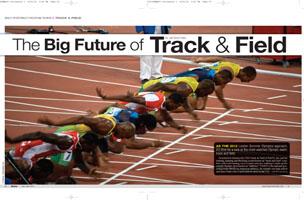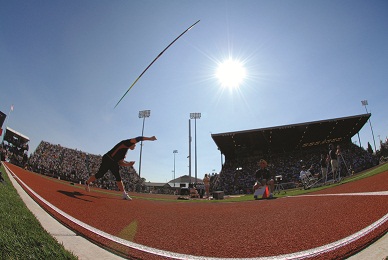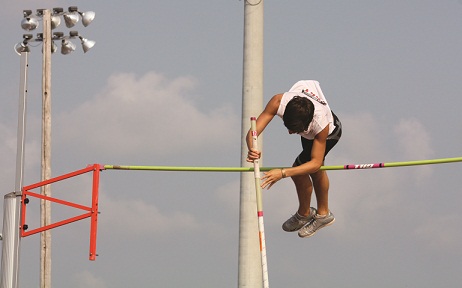
 |
| 2011 National Junior Olympic Cross Country Championships in Myrtle Beach, SC. Photo courtesy of Smotherman Images |
As the 2012 London Summer Olympics approach, it’s time for a look at the most-watched Olympic event: track and field.
Governed in America by USA Track & Field (USATF), the various running, jumping and throwing events known as “track and field” combine with road running, cross country and race walking to make up the overall Olympic sport known as “athletics.” USATF is the national governing body (NGB) for American athletics, the number one high school and junior high school participatory sport in the U.S.
One of the challenging aspects of hosting athletics events is the diverse range of events and regulations that comprise a meet. First there are the very different events of road running, cross country and race walking, but even within track and field events, there are two unique types of meets, indoor and outdoor, each with its own season, schedule, rules and championships.
“Indoor and outdoor track events bring a host of different requirements. The main difference is the track itself. Indoor track meets are run on a 200-meter track, and outdoor meets are run on a 400-meter track,” says Trevor Hartwig, Amateur Athletic Union Sport Manager. “The difference in track size, and the fact that the field events are in the same building for an indoor meet, bring a different planning aspect with regards to the spacing and number of events a facility can hold.”
Some conferences allow schools without access to an indoor track to use marks from outdoor tracks to qualify for indoor competitions.
 |
| Hayward Field. Photo courtesy of Dave Thomas |
“NAIA (National Association of Intercollegiate Athletics) says we can use outdoor marks to qualify for indoor, which is good because there’s only one indoor facility in an eight-hour radius,” says track and field coach Mike Rosolino, Embry-Riddle University. “We like that better because we find that our athletes get injured more on the indoor tracks, with their different surface and tighter turns.”
Athletics for All Ages
Led by its mission to “drive competitive excellence and popular engagement” in athletics, USATF provides development programs not only for potential future Olympians, but also for youth and adults of all ages. As public education budget cuts continue, athletics programs and opportunities for kids might be rare were it not for programs developed by USATF and a handful of other organizations, such as the Amateur Athletic Union (AAU).
“USATF programs offer something for any athlete, whether they want to have fun and make new friends while competing or participate on a more competitive route that might take them down the road to being a college athlete,” says Tricia Floyd, associate director of youth programs, USATF. “We have national events for all levels, too, based on personal achievement. You don’t have to be the fastest person to go to a national event. We want everyone to get experience, make friends and have a goal and something to work toward.”
 |
| 2011 USA Youth Outdoor Track & Field Championships in Myrtle Beach, SC. Photo courtesy of USATF. |
The Prospect Park Youth Running Club (PPYRC) in Brooklyn, New York, does just that. This March, the PPYRC athletes boarded a plane covered in medals, smiles and self-confidence. They were on their way back to Brooklyn after competing in the USATF National Youth Indoor Track & Field Championships in Bloomington, Illinois, one of many events this active youth running club attends each season.
One of the athlete’s parents, Sandra Mitchell, explained what makes a truly excellent youth track and field event: “The meets at the New York Track & Field Armory are always right on time, but what’s even more important is the officials. They have rules, but they’re really more about teaching the kids. If the kids need tips on passing the baton, they show them. It’s a great place for the kids to learn.”
With running clubs, track and field organizations and outstanding venues supporting the sport, it’s clear that the popularity of track and field has serious staying power. And USATF has a plan to take the sport even further.
Popular at Olympics time, track and field is not necessarily a hot spectator sport during non-Olympic years, but USATF has a plan to change that. For years, America’s elite athletics competitors have wished for more chances to compete in the U.S., with increased media exposure and prize money that would allow more elite athletes to make a living at the sport.
 |
| 2011 USA Youth Outdoor Track & Field Championships in Myrtle Beach, SC. Photo courtesy of USATF |
Beginning in 1988, USATF partnered with sponsor Visa to make that happen, and today the Visa Championship Series is a huge success with athletes and fans alike. Success has bred even more success, with additional sponsors joining the USATF mission. Since 1997, USATF has more than doubled it revenues, with a sponsor lineup that includes Visa, Nike, The Hershey Company, and 24 Hour Fitness.
In recent months, though, USATF has been gearing up for an Olympics season filled with high expectations, and for the moment, all eyes are on Track Town USA (also known as Eugene, Oregon).
Going for Gold
Home of the 2008 U.S. Olympic Track and Field Team Trials, Hayward Field, one of the world's most famous track and field venues, and Eugene’s massive team of organizers, planners and volunteers are set to exceed every expectation again this June for the 2012 Trials.
“I went to the USATF Annual Conference and listened to athletes talk about what it meant to them to compete at Hayward, and I saw them start to tear up,” says Janis Ross, executive director of the new Eugene, Cascades & Coast Sports Commission. “It’s awe-inspiring to hear how it feels to compete in a sold-out stadium where the fans really understand track and field. That’s our legacy in Eugene. That’s not something you take for granted.”
The Olympic Trials Organizing Committee led by the University of Oregon and the Oregon Track Club has amassed a group of over 2,000 volunteers to run the Trials. The group includes volunteers from all 50 states.
Hayward Field has been home to many of track and field’s historic moments, but what Eugene is probably most famous for is its fans. The stands at Hayward Field don’t just fill; they fill with fans who are devoted followers of track and field.
“With a city like Eugene, and you’ll find this across the board with any of our events—Youth Junior Olympics all the way to the Olympic Trials—a lot of the success has to do with the community hosting it,” says Jim Estes, associate director of marketing & LDR programs, USATF. “Our most successful events are the ones where the community is heavily invested, not only financially but also philosophically.”
Beyond a crowd that lifts every track and field event to a higher level, though, Hayward Field also represents the best in track and field facilities:
• Historic, covered grandstands with a 10,500 capacity
• 400-meter track with eight 48-inch lanes
• New all-weather advanced urethane surface installed in 2000.
• Steeplechase water jump has an inside location with the same surface as the track
• All field events are contested on the stadium infield for the best spectator viewing with the exception of the hammer throw
• Hammer throw is contested on a spacious nearby field adjacent to the south of the stadium. The hammer has its own seating area with viewing possible from the west grandstands. (For the 2012 Olympic Trials, the hammer throw will have a special home on the Nike Campus.)
“Eugene has always been a community that gets behind the Olympic Trials, Outdoor Championships, NCAA Championships,” says Estes. “You can just see the community’s commitment to giving everyone a true Eugene experience.”
 |
| Cooper sets 100 hurdle record. Photo courtesy of Winthrop University. |
Facilities for a Growing Sport
When Olympians do well, sports get a huge boost. Following swimming’s massive success in the 2008 Olympics (31 medals), USA Swimming experienced its largest membership growth in history. According to its 2008 annual report, USATF is aiming for 30 gold medals in the 2012 London Games, and some of the most promising athletes in years are gearing up to compete. So it’s a good thing that America is prepared for a track and field boon with amazing facilities from coast to coast.
York County, South Carolina
In Rock Hill, South Carolina, Winthrop University offers Irwin Belk Track, a $2.8 million track and soccer complex. Irwin Belk is an NCAA Division I competition facility with a Mondo rubberized surface. It encircles a full-sized practice field for soccer, as well as areas for field events, such as discus and pole vault. The track is located on Winthrop Garnet Drive near the golf course.
Also a renowned home for cross country events, Winthrop will be hosting the 2012 AAU National Cross Country Championships this December.
San Mateo, California
The College of San Mateo offers some of Northern California’s finest athletic facilities. The Bulldog track and field throwing area have both been recently renovated, including installation of a modern synthetic turf field and Mondo track surface on the 400-meter track. The track is equipped with nine 39-inch lanes. The facility also includes a separate field event area for throwing events, D-zone area with set up for multiple high jump and pole vault competitions and two runways for horizontal jumps.
Daytona Beach, Florida
In addition to leading a championship team, Coach Mike Rosolino is also helping track and field find a wider audience. This June, he and his Embry-Riddle team are presenting a beach pole vault competition in Daytona Beach. The event promises to draw athletes ranging from high school to semi-professional.
The team also regularly hosts meets at their renowned track and field complex, built in 2006. Seating 550, the complex has an eight-lane 400-meter track with 14mm Mondo Super track surface. Inside the track is a 120-by-70 yard soccer field with a Bermuda grass surface. There are bi-directional runways for the pole vault, long and triple jump, a high jump apron, and a water pit for steeplechase.
Louisville, Kentucky
Famed for its beautiful landscape, it’s not a big surprise that Louisville is a well-known destination for cross country events.
“The main events in the last couple of years were the 2010 NCAA Division 2 Fall Sports Festival, which determined the cross country champion, as well as the 2010 Midwest Regional Cross Country Meet at Tom Sawyer State Park,” says Jim Vargo, director of track and field/cross country, Bellarmine University. “They were very successful, and that’s because we were able to bring to bear the expertise and resources from the sports commission, Louisville CVB, the university and the conference, as well as community partners like the Ali Center and Churchill Downs.”
Beyond cross country, Bellarmine also has a world-class track and field facility. In the fall of 2007, Bellarmine dedicated its $5.1 million Owsley B. Frazier Stadium. Seating approximately, 2,000 this state-of-the-art facility includes an artificial field surface, an eight-lane Benyon dual-durometer polyurethane poured surface, as well as three long jump pits, two pole vault areas, a high jump pit, and a water steeplechase pool. In May 2010 a throws area was added across Newburg Road.
The University of Louisville is also home to some top-notch cross country and track and field facilities and events.
“Our partnerships with the Louisville Sports Commission, the city and all the government bodies that support sports events have really made Louisville the greatest sports town in America, and we work hard to live up to that,” says Ron Mann, head track and field coach, University of Louisville.
The University’s state-of-the-art Cardinal Park Soccer and Track Stadium opened in the fall of 2000 and provides a state-of-the-art track encircling a Bermuda grass field with seating for approximately 2,200. The track surface is Martin ISS 2000 embedded and has nine 48” lanes. All jump areas are located in large "D" zones inside each turn. The steeple water jump is also inside the turn and is adaptable for the women's event, while the throws field is approximately 500 meters south and west of the stadium and provides lightly brushed concrete circles and a full rubberized javelin runway.

